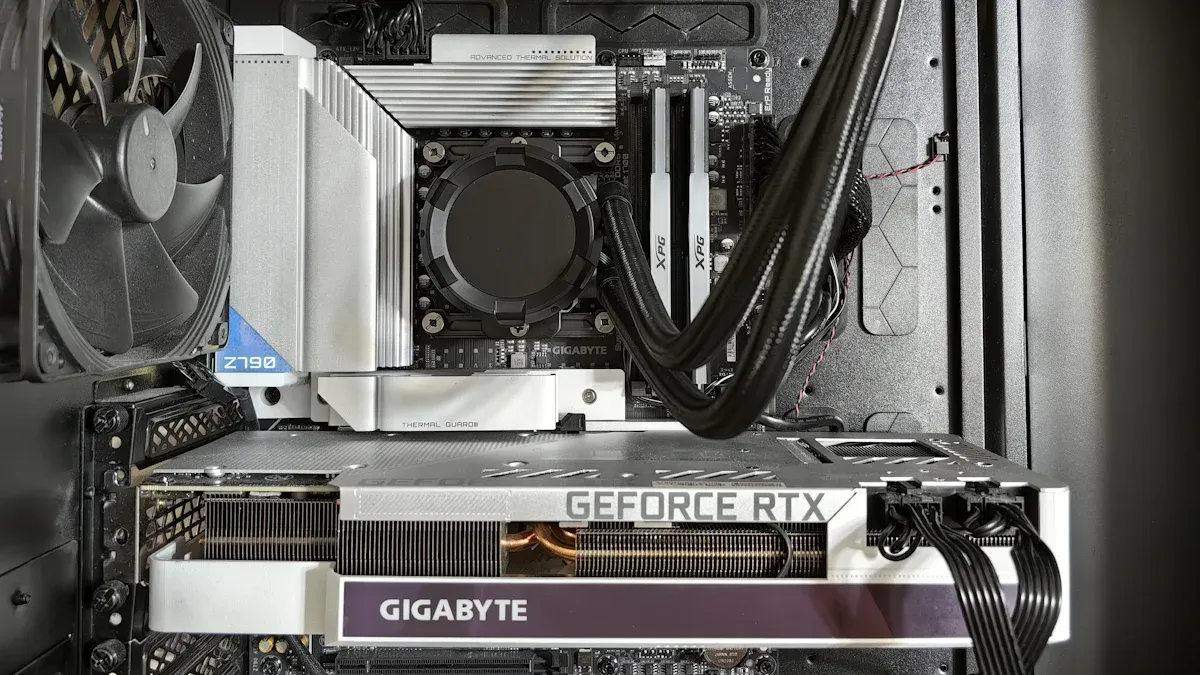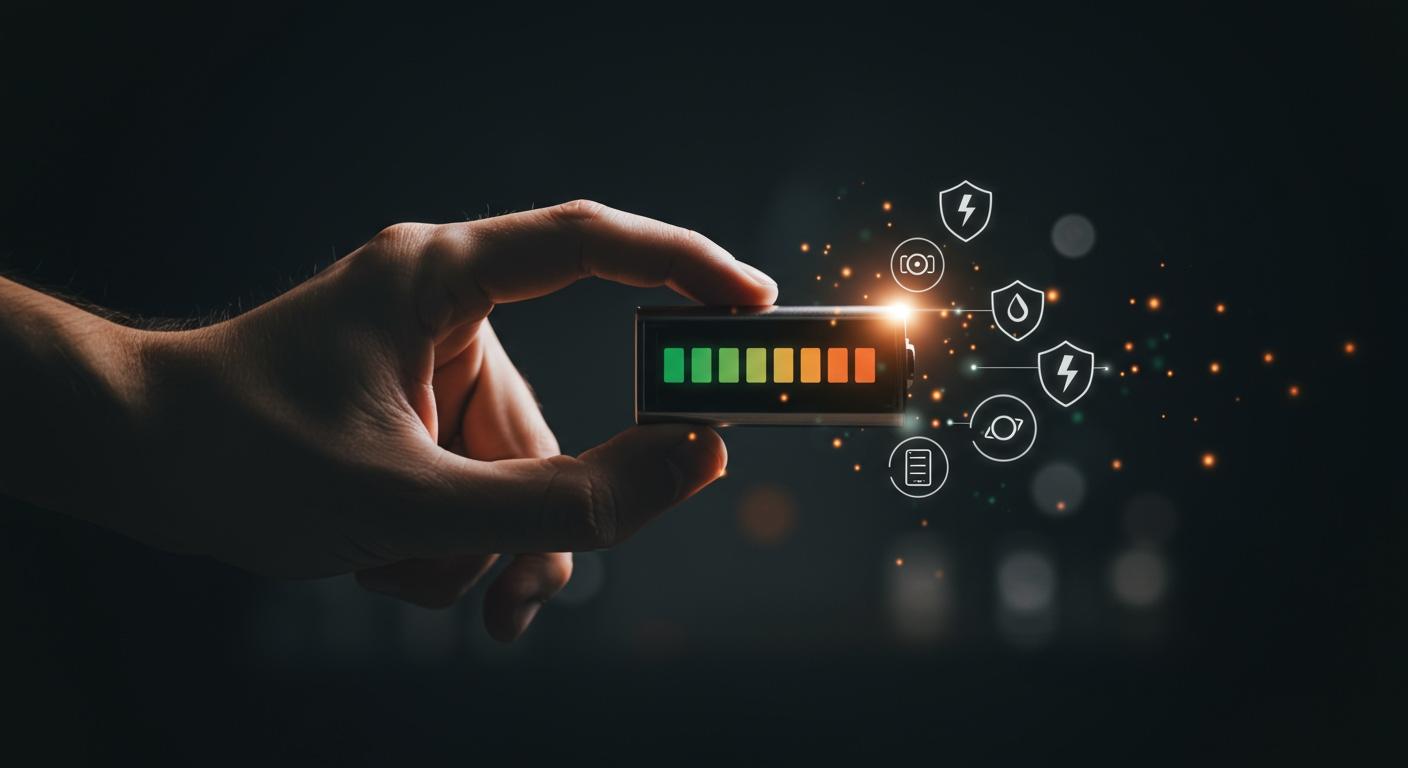How to extend the lifespan of rechargeable lithium-ion batteries
Simple daily habits can make your rechargeable lithium-ion batteries last much longer. Charge levels, temperature, and storage all play a big role in battery health. Keeping your device at a steady temperature and avoiding extreme charging patterns can make a real difference. Recent studies show that optimal charging and temperature control can extend battery life by almost 50%.
| Key Findings | Implications |
|---|---|
| Keeping battery temperature steady reduces capacity loss. | Longer lifespan and improved safety. |
| Using the right charging methods slows battery aging. | Batteries last up to 48.6% longer. |
Take a moment to consider how you currently treat your devices—small changes can add up over time.
Key Takeaways
- Keep your battery charge between 20% and 80% to reduce stress and extend its life.
- Avoid letting your battery fully discharge. Charge it before it drops below 20% to prevent damage.
- Unplug your device once it reaches 100% to avoid overcharging, which can harm the battery.
- Store batteries at a charge level of 40% to 60% in a cool, dry place to maintain their health.
- Regularly check your battery's health and use smart chargers to optimize performance and safety.
Charging Tips for Rechargeable Lithium-Ion Batteries
Keeping your rechargeable lithium-ion batteries healthy starts with smart charging habits. You can extend the lifetime of your devices by understanding how charging routines affect battery chemistry. Avoiding extreme charge levels and following a few simple rules will help you get the most out of every charge.
Avoid Full Discharges
Letting your battery drain all the way to zero can cause lasting damage. When you use a lithium-ion battery until it is empty, chemical changes happen inside that speed up wear and tear.
In the Advanced Energy Materials paper, researchers showed that when a lithium-ion battery is used for extended periods without recharging, a phenomenon known as the “quasi-conversion reaction” occurs on the positive electrode (cathode) surface, accelerating battery degradation. By optimizing battery usage and avoiding full discharge, they could maintain 73.4% of a batteries’ capacity after 300 cycles.
A method to prolong the battery cycle lifetime is proposed, in which the lower cutoff voltage is raised to 3 V when the battery reaches a capacity degradation threshold. The results demonstrate a 38.1% increase in throughput at 70% of their beginning of life (BoL) capacity.
Battery manufacturers recommend that you avoid letting your battery reach zero. Here are some tips you can follow:
- Do not wait until your device shuts off before charging.
- Try to keep the battery charge above 20%.
- Recharge your device when you see the battery getting low, but not empty.
These habits will help you avoid deep cycling and keep your battery running longer.
Don’t Overcharge
Charging your battery past 100% or leaving it plugged in for long periods can also shorten its lifetime. Overcharging causes physical and chemical changes inside the battery that can lead to safety risks and faster aging.
| Study | Findings |
|---|---|
| Qi et al. [26] | Cell volume increased rapidly during overcharge, leading to electrode material pulverization. |
| Ouyang et al. [27,28] | Deterioration of electrode kinetics caused significant capacity degradation with overcharge cycling. |
| Liang et al. [30] | Exothermic rate increased sharply when cell voltage exceeded 4.5V, leading to oxidation of electrode and electrolyte. |
| Liu et al. [33] | Thermal stability decreased gradually with slight overcharge cycling. |
| Wang et al. [37] | Maximum pressure increased with charge rate during overcharge. |
| Mei et al. [47] | Lithium plating first occurred at the anode-separator interface, leading to further degradation. |
You can see that overcharging leads to:
- Increased cell volume and damage to the battery’s internal parts.
- Faster loss of capacity and performance.
- Higher risk of overheating and even failure.
Modern devices use special technologies to prevent overcharging. Here are some examples:
| Technology | Description |
|---|---|
| Wireless Charging | Uses safety mechanisms to control heat and prevent overcharging, providing a convenient charging option. |
| Three-Stage Chargers | Utilize a multi-stage charging process consisting of bulk, absorption, and float stages to prevent overcharging and maximize battery life. |
| Smart Chargers | Incorporate advanced technology to monitor and control the charging process, adjusting rates based on battery condition. |
You should unplug your device once it is fully charged or use chargers with built-in safety features. This will help protect your battery’s lifetime and keep your device safe.
Maintain 20%-80% Charge
Keeping your battery between 20% and 80% charge is one of the best ways to extend its cycle life. Charging all the way to 100% or letting it drop below 20% puts extra stress on the battery’s chemistry.
| Recommendation | Benefit |
|---|---|
| Keeping the charge between 20-80% is ideal for most Lithium ion battery technologies. | Reduces electrochemical stress and slows aging. |
| Maintaining 20%–80% Charge Range to Minimize Aging | Cuts down on the electrochemical stress lithium ion batteries experience over time. |
| Partial recharges (20-80%) vs. full cycles (0-100%) | Partial recharges are kinder and give your battery a longer life than full cycles. |
You can follow these daily charging routines to maximize your battery’s lifetime:
- Learn how your device displays battery health and charge levels.
- Use chargers that follow the CCCV (Constant Current, Constant Voltage) process.
- Charge slowly when possible to reduce heat and stress.
- Keep your device cool while charging.
- Recharge before your battery drops below 20%, and unplug before it reaches 100%.
Tip: Favor partial charging and avoid both full discharges and overcharging. This simple habit will help your rechargeable lithium-ion batteries last much longer.
By following these charging tips, you will protect your battery’s cycle life and enjoy reliable performance for years.
Temperature Management

Temperature plays a major role in the lifetime and performance of your rechargeable lithium-ion batteries. By managing heat and cold, you can protect your battery’s cycle life and keep your devices running smoothly.
Avoid Heat
High temperatures can damage your battery’s chemistry and shorten its lifetime. When your battery gets too hot, several problems can occur:
- The formation of hydrofluoric acid (HF) at high voltage can severely deteriorate cycling performance.
- High voltage charging can cause electrolyte oxidation, which forms a high impedance film on the electrodes and reduces performance.
- Even at 60°C, some batteries can last for many cycles, but most will lose capacity faster in heat.
You should keep your devices out of direct sunlight and away from heat sources. Try not to leave your phone or laptop in a hot car. If your device feels warm, let it cool down before using or charging it.
| Operation Type | Temperature Range |
|---|---|
| Charging | 0°C to 45°C (32°F to 113°F) |
| Discharging (Usage) | -20°C to 60°C (-4°F to 140°F) |
| Long-Term Storage | 15°C to 25°C (59°F to 77°F) |
Prevent Cold Exposure
Cold temperatures can also harm your battery. When exposed to cold, your battery’s chemical reactions slow down, which leads to reduced capacity and efficiency. Charging in cold conditions can cause lithium plating, which permanently damages the battery and shortens its lifetime.
- Cold batteries lose charge and operate less efficiently.
- Below freezing, the anode cannot capture lithium ions well, which reduces capacity.
- Charging at low temperatures can make the battery unstable and increase the risk of failure.
To protect your battery in cold weather:
- Insulate batteries with padded pouches or thermally lined containers.
- Store batteries above 0°C and keep them dry.
- Use body heat to keep spare batteries warm outdoors.
- Always warm batteries to room temperature before charging.
Let Devices Cool Before Charging
Charging your device right after heavy use can raise its temperature even more. High temperatures and frequent full charges both speed up battery aging. You should let your device cool down before plugging it in. This simple habit helps extend the lifetime of your battery and keeps it safe.
Storage Guidelines

Proper storage plays a big role in the lifetime and cycle life of rechargeable lithium-ion batteries. If you plan to store your batteries for more than 30 days, you need to follow a few best practices for lithium-ion battery lifetime extension.
Store at 50% Charge
You should never store your batteries fully charged or completely empty. Most manufacturers recommend storing batteries at a charge level between 40% and 60%. This range helps slow down self-discharge and keeps the battery healthy during long periods of inactivity.
- Store batteries at 30% to 50% charge for optimal performance and longevity.
- For long-term storage, keep the charge at 40% to 50% and recharge to about 50% every 3–6 months.
- Adjust the charge level to between 40% and 60% before storage to extend storage time.
Keeping your battery at this intermediate charge level helps preserve its performance and prevents excessive self-discharge.
Choose a Cool, Dry Place
The environment where you store your batteries matters just as much as the charge level. High temperatures and humidity can damage the battery’s internal structure and reduce its lifetime.
- Store batteries in a cool, dry place, ideally at room temperature.
- Avoid extreme temperatures below -13°F (-25°C) or above 149°F (65°C).
- Keep batteries away from direct sunlight and high humidity.
- Make sure the storage area has good ventilation.
High temperatures above 25°C can speed up capacity loss, while high humidity can cause corrosion and internal damage. A cool, dry, and well-ventilated space helps prevent these problems.
Avoid Long-Term Inactivity
Leaving batteries unused for months can lead to self-discharge, capacity loss, and increased internal resistance. To keep your batteries healthy, you should check and recharge them regularly.
| Maintenance Step | Description |
|---|---|
| Keep cool and dry | Store batteries in a cool, dry place to prevent moisture damage and temperature-related degradation. |
| Partial charge for long-term storage | If storing batteries for an extended period, keep them at around 50% charge to maintain health. |
| Regular checks | Periodically check stored batteries and recharge if their charge falls below recommended levels. |
| Avoid inactivity | Even when not in use, occasional charging cycles can help maintain battery health. |
By following these storage guidelines, you can maximize the lifetime of your rechargeable lithium-ion batteries and ensure they deliver reliable performance when you need them.
Battery Maintenance
Taking care of your rechargeable lithium-ion batteries helps you get the most out of their lifetime and cycle life. You can use simple tools and smart systems to keep your batteries healthy and working well.
Monitor Battery Health
You should check your battery health regularly. This helps you spot problems early and keep your devices running longer. Many tools and apps make this easy. Here are some options:
| Tool Name | Description |
|---|---|
| PowerShield8 | Shows battery health and performance at the cell level with dashboards. |
| Cadex C7000 | Gives in-depth diagnostics for battery health. |
| BatteryInfoView | Lets you analyze battery health on your computer. |
| CellSage | Models battery capacity loss and helps with design decisions. |
You can follow these steps to keep your batteries in good shape:
- Check battery health every 3-6 months using dashboard readings.
- Do a full assessment once a year or before making big decisions about your device.
Tip: Regular checks help you catch issues before they affect your battery’s lifetime.
Use Smart Management Systems
Smart battery management systems protect your battery and improve its performance. These systems use sensors and software to monitor and control charging, temperature, and usage.
Benefits of using a battery management system include:
- Enhances safety by preventing overheating.
- Improves performance through efficient battery usage.
- Extends battery life by optimizing charging processes.
Smart systems also help prevent common problems:
- Detect risks like overcharging and overheating.
- Monitor state of charge and state of health to avoid deep discharges.
- Keep batteries in the best temperature range for longer lifetime.
- Use real-time data to predict performance and reduce cell stress.
- Control cooling and heating to keep batteries safe.
Update Software
Keeping your device software up-to-date helps your battery last longer. Updates often add new power-saving modes and improve how your device uses energy. You may notice better battery life after an update.
- Updates can add emergency power-saving features.
- They adjust screen brightness, CPU speed, and network use based on battery level.
- Firmware improvements make processors more efficient, lowering energy use.
- Companies like Apple, Samsung, and Google release updates that fix battery drain and shutdown issues.
Note: Always install the latest firmware to solve battery-related problems and boost your device’s lifetime.
Common Mistakes
Charging Myths
Many people believe myths about charging lithium-ion batteries. These misconceptions can lead you to use your devices in ways that shorten battery lifespan. You might hear advice that sounds helpful but does not match scientific research.
| Myth | Explanation |
|---|---|
| Extended Initial Charging | You do not need to charge new lithium-ion batteries for 12 hours before first use. They work right away. |
| Overcharging is Harmless | Overcharging can break down the electrolyte, create gas, and even rupture the battery. This reduces lifespan. |
| Deep Discharges are Safe | Letting your battery drop below 20% often causes permanent damage and speeds up aging. |
You may think that charging your device fully before first use is necessary. This idea comes from older battery types. Lithium-ion batteries ship with a charge level between 40% and 60%. This range helps keep the battery healthy during storage. Charging habits that involve deep discharging can wear out your battery faster.
Tip: Trust the manufacturer’s instructions. You do not need to perform long initial charges or let your battery drain completely.
Harmful Habits
Some daily habits can harm your battery without you realizing it. You should avoid these practices to keep your battery in good condition.
- Charging your device in very hot or cold places can damage the battery’s chemistry.
- Deep discharging and frequent full charges use up the limited number of cycles your battery has.
- Ignoring the state of health of your battery can lead to unexpected shutdowns and poor performance.
- Leaving your device plugged in after it reaches 100% can cause overheating and reduce lifespan.
- Using cheap or uncertified chargers may not protect your battery from voltage spikes or overcharging.
You can protect your battery by charging in safe temperature ranges and unplugging once charged. Regularly check your battery’s state of health to catch problems early. Choose certified chargers and avoid letting your battery drop below 20%.
Remember: Small changes in your habits can make your battery last much longer. Stay informed and use your devices wisely.
You can extend the lifespan of rechargeable lithium-ion batteries by following simple habits every day. Keep your batteries between 20% and 80% charge, avoid deep discharges, and store them at a cool, stable temperature.
Maintaining batteries in the optimal charge range can extend cycle life by up to 300%.
Check the state of health regularly to catch problems early.
| Temperature Range | Capacity Loss | Cycle Count |
|---|---|---|
| 45°C | 40% | 300 cycles |
| 25°C | 20% | 1200 cycles |
| Below 0°C | Irreversible loss | N/A |
Small changes in your routine make a big difference. Apply these tips and watch your battery performance improve.
-

 May.2025.11.24Ternary Lithium Battery vs Lithium-ion: Complete Comparison Guide (2025 Edition)Learn More
May.2025.11.24Ternary Lithium Battery vs Lithium-ion: Complete Comparison Guide (2025 Edition)Learn More -

 May.2025.11.214S2P 18650 14.8V Battery: Complete Technical Guide, Specs, Applications & SafetyLearn More
May.2025.11.214S2P 18650 14.8V Battery: Complete Technical Guide, Specs, Applications & SafetyLearn More -

 May.2025.11.18PCM vs BMS in Lithium Batteries: What’s the Difference and Which One Do You Need?Learn More
May.2025.11.18PCM vs BMS in Lithium Batteries: What’s the Difference and Which One Do You Need?Learn More -

 May.2025.11.17Custom Li-ion Battery Design for Medical Devices (2025 Comprehensive Guide)Learn More
May.2025.11.17Custom Li-ion Battery Design for Medical Devices (2025 Comprehensive Guide)Learn More -

 May.2025.11.17The Future of Lithium-Ion Batteries: Innovation, Sustainability, and Global Market TrendsLearn More
May.2025.11.17The Future of Lithium-Ion Batteries: Innovation, Sustainability, and Global Market TrendsLearn More
















